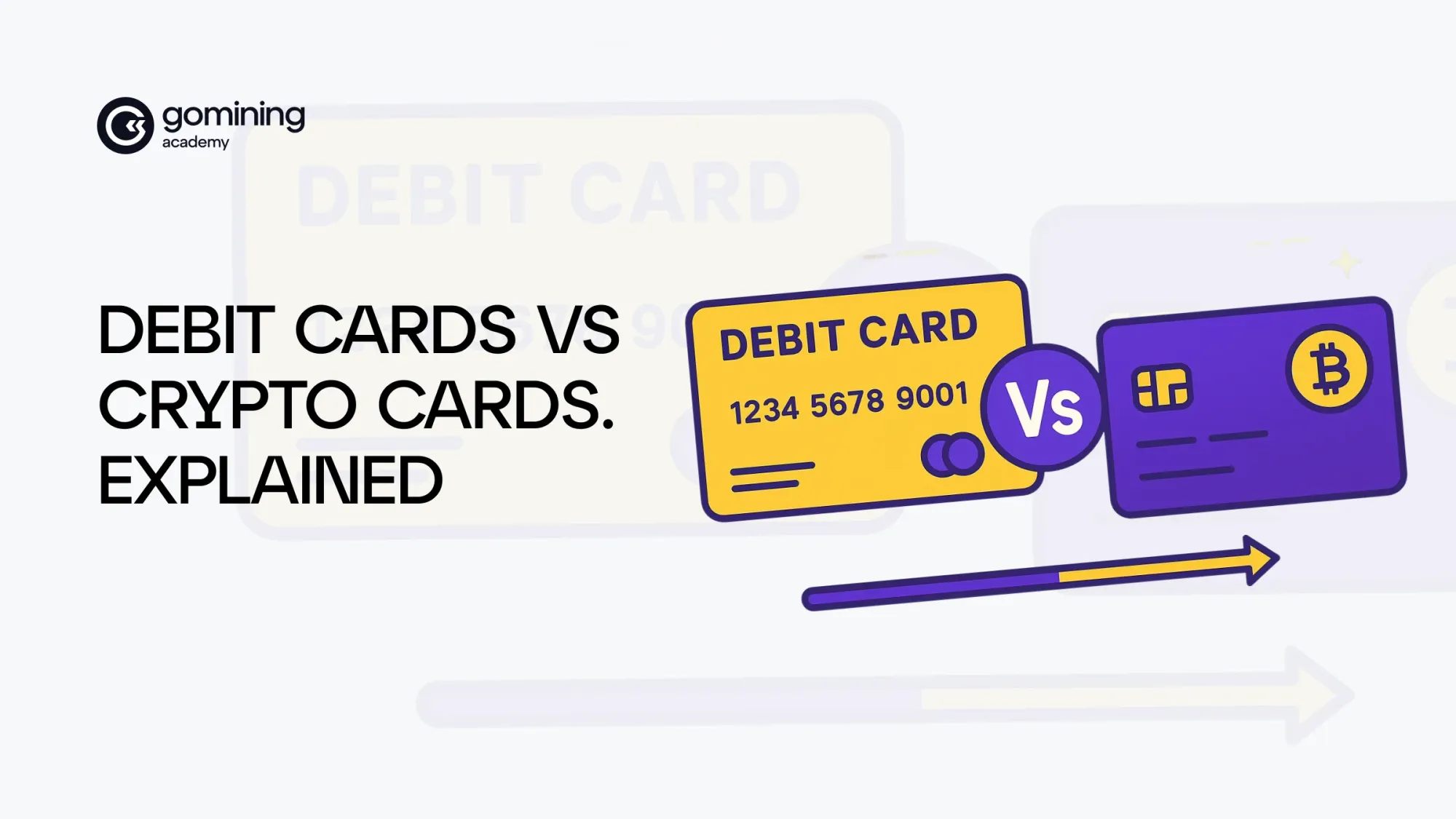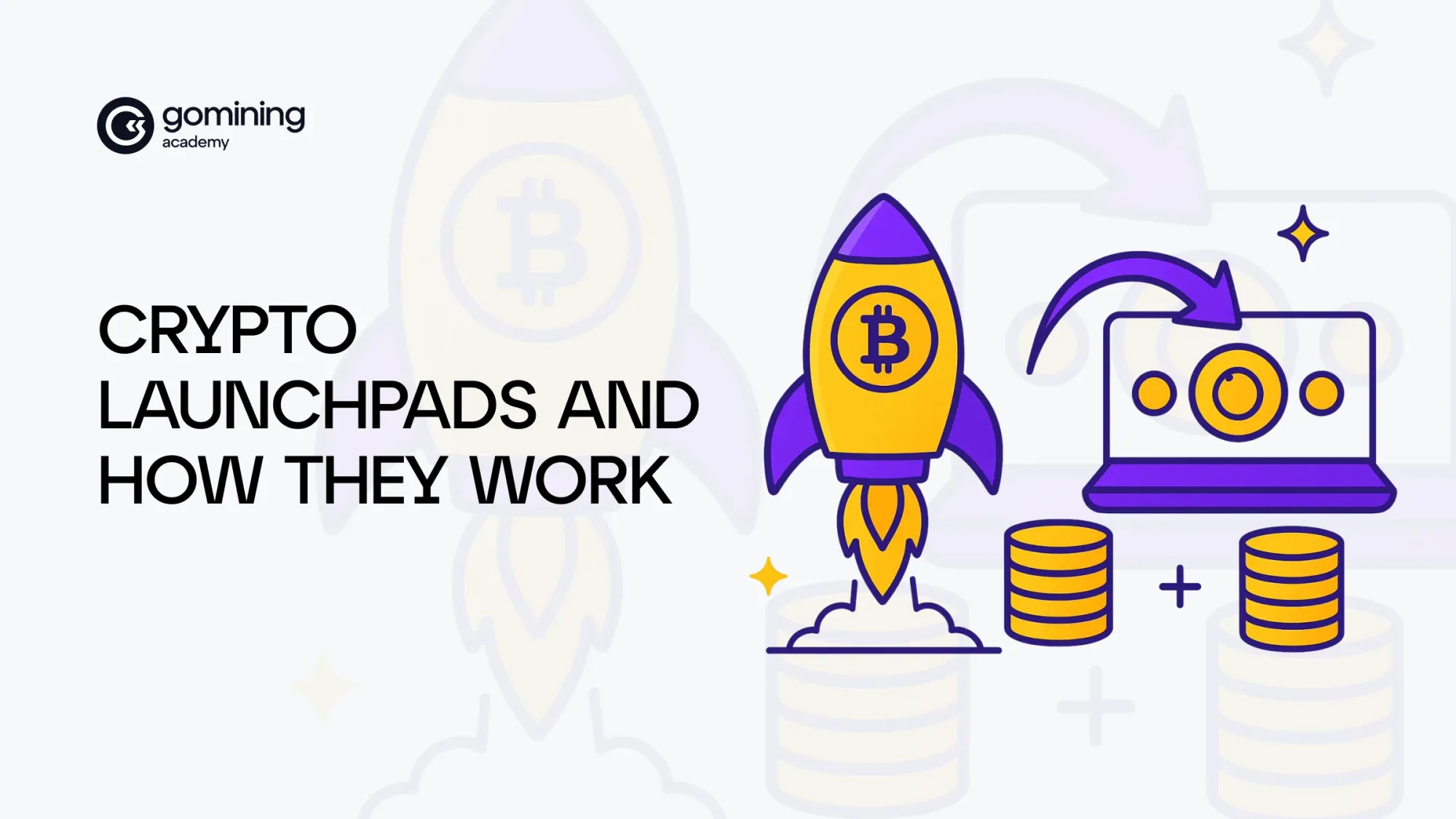Bitcoin Mining Equipment: How to Choose in 2025
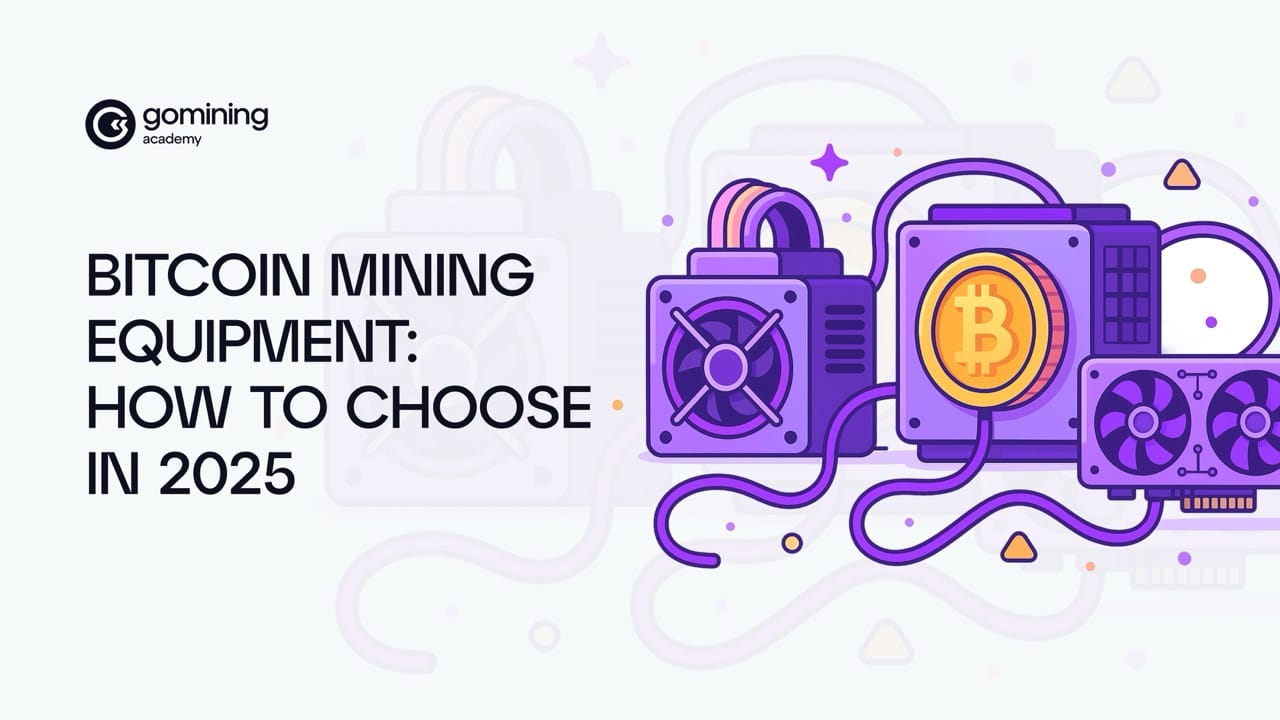
Let’s face it — Bitcoin mining equipment in 2025 isn’t what it used to be in 2011. Or even 2015.
You can’t just plug in your dusty gaming PC and expect digital gold to start pouring in. These days, it’s more like prepping for a tech-powered treasure hunt, where success depends on the gear you bring to the game. The good news? You’ve got options. The better news? We’ll walk you through them, without the jargon or the headache.
In this article, we will look at Bitcoin mining equipment in 2025 and explore what choices exist for miners, whether you’re after the latest Bitcoin mining hardware, a high-powered Bitcoin mining device, or simply want the most reliable mining equipment for cryptocurrency — all depending on your budget and appetite for risk.
So, You Wanna Be a Bitcoin Miner in 2025?
Whether you’re a beginner curious about BTC mining equipment, or someone wondering what kind of crypto miner hardware gives the best bang for your buck, this guide has your back. We’ll break down the Bitcoin mining machines making waves in 2025, show you how to compare costs and performance, and even introduce you to equipment for mining cryptocurrency—including both classic rigs and modern digital solutions.
Let’s dig in (pun fully intended).
Table of Contents:
- What Is Bitcoin Mining Equipment?
- From CPUs to ASICs: A short history
- Why GPUs no longer cut it
- What you actually need to mine Bitcoin now
- Top Bitcoin Mining Equipment And Costs
- ASIC miners explained
- Hash Rate, Efficiency, Power Draw… Let's Talk Specs
- Popular models: Bitmain, MICROBT & Avalon
- Bitcoin Mining Equipment Costs: What You’ll Spend Before You Earn
- Bitcoin Mining Equipment, Cooling, Electricity, Location
- Common pitfalls and hidden costs
- An Online Solution For Bitcoin Mining Equipment?
- Cloud Mining
- Digital Mining
- GoMining, Your Online Bitcoin Mining Device
- BTC Mining Equipment: When to Go Big, When to Go Remote
- Final thoughts for 2025 miners
What Is Bitcoin Mining Equipment?
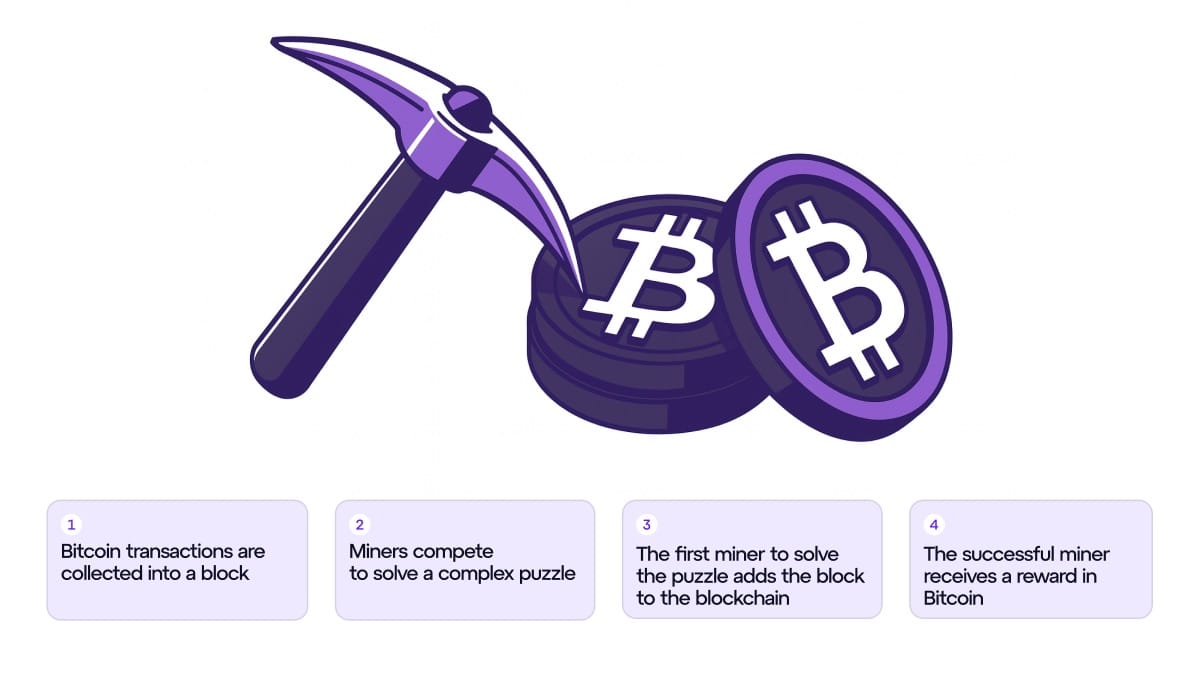
Bitcoin mining equipment for cryptocurrency is the specialized hardware used to verify Bitcoin transactions and secure the blockchain—in return for earning Bitcoin rewards. Some call it crypto mining equipment or just mining hardware; all these terms refer to the powerful devices—like Bitcoin mining machines and ASIC Bitcoin mining devices—that keep the blockchain running. In simple terms, this equipment guesses a winning number in a huge digital lottery every ten minutes. If your machine guesses it first, you win Bitcoin. But the guessing isn’t random—it’s powered by serious crypto mining hardware muscle.
From CPUs to ASICs: A Short History
In Bitcoin’s early days (think 2009–2011), regular computers with basic CPUs (Central Processing Units) could mine Bitcoin. Then came the rise of GPUs (Graphics Processing Units), which are more powerful and could process many guesses at once — like upgrading from one fishing line to a net.
Eventually, as more people joined the network, the competition exploded — and so did the difficulty of mining. Enter ASICs (Application-Specific Integrated Circuits): custom-built machines designed only to mine Bitcoin. These beasts are way faster and more efficient than anything before them. Today, ASIC miners dominate the landscape, and if you’re not using one, you’re basically out of the race.
Why GPUs No Longer Cut It
GPUs still work great for mining some other cryptocurrencies (like Ethereum Classic or Ravencoin), but for Bitcoin, they’ve been left in the dust. Bitcoin’s mining difficulty has scaled so high that using a GPU would be like bringing a bicycle to a Formula 1 race. Sure, you’re moving — but you’re not going to win.
Modern ASICs can perform trillions of hashes per second, while even the best GPUs fall thousands of times short. Worse still, the electricity you’d burn running a GPU miner would cost you more than the Bitcoin you’d earn. That’s why serious miners — even solo hobbyists — have moved to ASIC-based rigs.
What You Actually Need to Mine Bitcoin Now
So, what does it take to mine Bitcoin in 2025? Here's your essential checklist:
- An ASIC miner: Stands for Application-Specific Integrated Circuit. Wonder what that means in plain English? These are Bitcoin mining machines or crypto mining equipment designed from the ground up to mine Bitcoin—nothing more, nothing less.
- Stable electricity: Mining uses a lot of power, so cheap and reliable electricity is critical. Otherwise, you could end up paying more for energy than you earn in Bitcoin.
- Cooling and ventilation: These Bitcoin mining devices get hot—think hairdryer-on-full-blast hot—so you’ll need fans, ventilation, or even immersion cooling in larger setups.
- Bitcoin mining software: This connects your hardware to the Bitcoin network or a mining pool.
- A digital wallet: This is where your mined Bitcoin goes — a secure place to store your rewards.
Top Bitcoin Mining Equipment And Costs
ASIC Miners Explained
ASICs are what make modern Bitcoin mining equipment so powerful and efficient in today’s mining environment. They’re fast, power-hungry, and purpose-built. Every serious mining farm today runs on rows and rows of ASICs, not because they’re trendy—but because they’re the only mining equipment for cryptocurrency that can keep up with Bitcoin’s high mining difficulty. Bitcoin mining hardware has come a long way, and in 2025, it’s all about ASICs—ultra-efficient crypto mining machines made to do one thing and do it well: mine Bitcoin.
Hash Rate, Efficiency, Power Draw… Let's Talk Specs
Before diving into Bitcoin mining equipment, let's clear up some key specs you’ll see over and over. If you’re new to this, terms like “TH/s” or “J/TH” might look like gibberish. No worries – they’re easier than they sound!
Here are the big core mining specs that are crucial when it comes to understanding Bitcoin mining and miner efficiency:
- Hash Rate (TH/s) – This is basically how fast a miner can work. A hash is like a guess in the Bitcoin lottery. A higher hash rate means your machine is guessing more numbers per second. Hash rate is measured in terahashes per second (TH/s), which literally means trillions of guesses every second.
🔄 Think of it like scratching a trillion lottery tickets per second! A miner with 100 TH/s is checking 100 trillion possible “lucky numbers” every second. The higher the hash rate, the more chances you have to win that mining reward.
- Power Efficiency (J/TH) – Mining hardware eats up electricity, and efficiency tells you how hungry your miner is. It’s given in joules per terahash (J/TH), meaning how many units of energy (joules) the device needs to make one trillion guesses. Lower is better here – it means the machine uses less energy for the same work. And what’s a joule? It’s a tiny unit of energy – about the amount needed to lift a small apple from the floor up to a coffee table.
🍏 So if a miner is rated at 30 J/TH, imagine it uses the energy of lifting 30 apples for every trillion lottery tickets it scratches. An efficient miner squeezes more work out of every bit of power, saving you money on electricity.
- Power draw (Watts) – Refers to how much electricity a piece of Bitcoin mining equipment uses while it’s running — typically measured in watts (W). It tells you how energy-hungry your miner is, and it directly affects how much you’ll pay in electricity costs. For example, if a mining rig has a power draw of 3,400W, that means it uses 3.4 kilowatts every hour it runs. If electricity costs $0.05 per kWh, that miner would cost about $4.08 to run for 24 hours. Why does it matter? Because more efficient miners do more work (higher hash rate) with less power, giving you a better return on your investment. When comparing miners, it’s smart to look at efficiency (measured in joules per terahash, or J/TH), which combines power draw and performance into one neat number.
Think of it like this: compare Bitcoin mining equipment to performance cars. The hashrate (TH/s) is your top speed—how fast you can chew through complex equations and process blocks. The efficiency (TH/J) is your fuel economy—how far you can go on a single gallon of electricity. And power draw is how much gasoline(electricity watts in mining gear) does your car need to run.
Popular Models: Bitmain, MICROBT & Avalon
Several major brands dominate the ASIC mining scene in 2025:
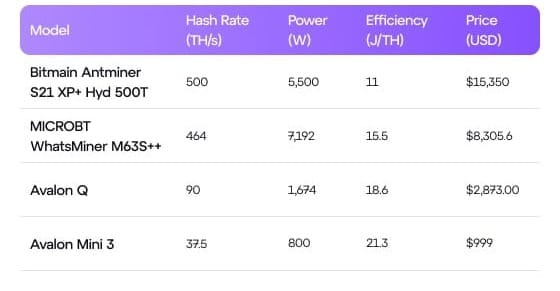
It's common for amateurs to purchase machines like the Avalon Q or Avalon Mini 3 for a balance of price, performance, and ease of use. More professional ecosystem players usually opt for high-end, high-hashrate, and water-cooled models like the Antminer Bitmain Antminer S21 XP+ Hyd 500T, or MICROBT WhatsMiner M63S++ to maximize profitability in large-scale operations.
If you're curious to learn more on why this is the case, we'd suggest diving into this research by Cointelegraph that covers this topic in greater detail.
Mining Hardware: What You’ll Spend Before You Earn
Mining Bitcoin isn’t just about plugging in a fancy machine and watching the coins roll in. Before you earn your first satoshi (1 satoshi = 0.00000001 BTC), you’ll need to make some upfront investments — and they can add up fast. Let’s break down where your money goes and why more miners are choosing a digital route in 2025.
Bitcoin Mining Equipment, Cooling, Electricity, Location
First and foremost, you’ll need actual Bitcoin mining equipment—which usually means investing in an ASIC miner. These can cost anywhere from $2,000 to over $14,000 depending on the model and its efficiency. Choosing the right crypto mining equipment, or BTC mining hardware specifically, will shape your overall profits, so compare specs carefully.
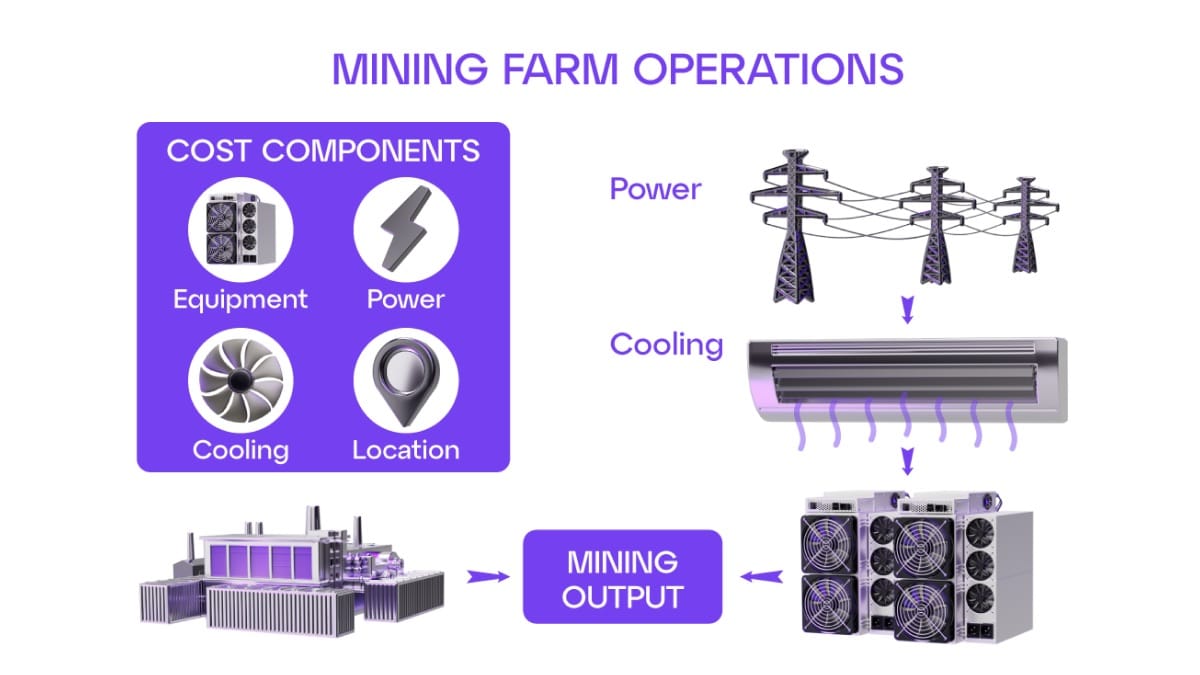
But that’s just the beginning. ASICs run hot, and heat means cooling. You’ll likely need industrial fans, ventilation systems, or even immersion cooling setups to keep your gear from frying. That can easily tack on hundreds or thousands more in setup costs.
Then there’s electricity. Mining hardware consumes a massive amount of power. At a rate of $0.05 per kWh, running a single high-end ASIC 24/7 could cost over $200/month. In areas with higher energy prices, the math may not work in your favor.
And finally, location matters. Are you mining at home? Get ready for noise, heat, and possibly complaints from neighbors. Industrial setups might require rented warehouse space — with all the added security and infrastructure costs.
Common Pitfalls and Hidden Costs
Many new miners make the mistake of only budgeting for the Bitcoin mining machine itself—but real-world mining comes with curveballs. Beyond the cost of crypto mining equipment, you’ll need to consider:
- Cooling
- Electricity
- Shipping fees and import taxes for miners from overseas
- Upgrades and replacements as hardware becomes outdated
- Internet and networking gear to keep your rig online
- Maintenance — dust, wear-and-tear, and even pests (yes, really)
And perhaps the biggest one: downtime. If your machine goes offline due to power cuts, overheating, or connection issues, you’re not earning anything — but you’re still paying for electricity.
An Online Solution For Bitcoin Mining Equipment?
Remember when people used to buy DVD players and hoard CD collections like dragons with treasure? Later, we all moved on to a more advanced and hassle-free solution. These days, we stream everything our movies, music, and keep our photos in a cloud. And guess what? Bitcoin mining had a glow-up too. You no longer need a noisy machine growling in your garage to get in on the action. Now you can mine Bitcoin straight from the cloud or with a little digital miner. It’s crypto’s version of “Spotify”.
Cloud Mining
Cloud mining is a method where users rent mining power (hashrate) from a third-party provider that owns and manages the physical mining hardware in remote data centers. Users pay a fee to the provider, who maintains the equipment and handles all operational aspects. The user receives a share of mining rewards proportional to the amount of hashrate rented.
- Pros: No need to buy, set up, or maintain hardware; lower technical barrier to entry; accessible from anywhere.
- Cons: Less transparency and control; potential for scams or hidden fees; profits are shared and can be lower due to provider costs; centralization risk.
Digital Mining
Digital mining is a newer approach that skips the need for having physical Bitcoin mining equipment at home, letting users access mining power through digital assets that represent real Bitcoin mining machines hosted in professional data centers. These digital miners are backed by actual mining hardware—giving you the same performance and daily rewards as traditional setups, but without the hardware headaches.
- Pros: More transparency and user control; you own your digital miners and they are tradable and can be scaled or upgraded; no hardware hassles; often more flexible and efficient than traditional cloud mining.
- Cons: Still relies on third-party infrastructure; rewards can vary with mining difficulty and market conditions; newer concept, so long-term reliability depends on the provider.
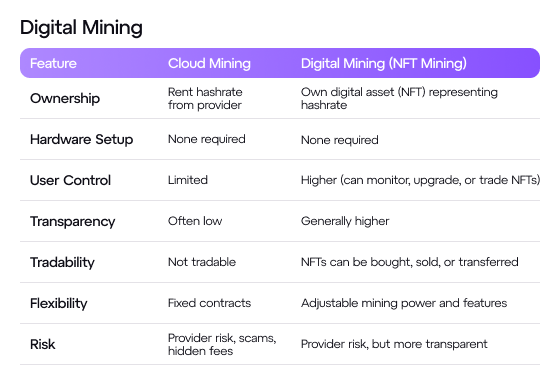
GoMining, Your Digital Bitcoin Mining Device
While traditional miners need to calculate power costs, cooling, and maintenance just to see if they’ll break even, digital mining solutions like GoMining simplify the math. You can use the crypto mining calculator to estimate daily or monthly BTC earnings instantly—no spreadsheets or guesswork required.
Instead of managing the heat and noise of warehouse-scale setups, you own an NFT-backed share of real hashpower providers operating in pro-grade data centres. These miners run 24/7, and your share of rewards flows directly into your account daily. It’s a hands-off approach that still delivers real mining income without huge up-front costs or complicated mining equipment maintenance headaches.
GoMining also rewards commitment. Paying fees with the native GoMining token can cut maintenance costs by up to 20%, while the GoMining VIP loyalty program offers even deeper discounts for long-term users. The entire system is designed with clear tokenomics to keep incentives transparent and sustainable over time.
Beyond raw earnings, GoMining adds a fun, customizable layer with digital miner collection options, unique GoMiners digital avatars, and even competitive mining games that turn hashing power into an interactive strategy experience. Whether you’re mining for profit or exploring how crypto mining works without the hassle of physical equipment, GoMining offers an accessible, beginner-friendly onramp into the world of Bitcoin rewards.
BTC Mining Equipment: When to Go Big, When to Go Remote
Whether you're dreaming of a buzzing home rig or exploring hands-free digital mining, your choice should reflect your goals, budget, and risk tolerance. ASIC miners offer raw power and control—but they also come with heat, noise, and maintenance. Services like GoMining let you tap into professional-grade equipment hosted around the world—no physical setup, no surprise power bills, and no hardware headaches.
Here’s the golden rule: you don’t need to mine like a pro to earn like one. Start small, stay curious, and remember that the best miner is the one that works for you, not the other way around.
Final Thoughts for 2025 Miners
So, what do you need to mine Bitcoin today? Whether it’s a top-tier ASIC, tried-and-true crypto mining hardware, or the latest Bitcoin mining equipment managed online, your decision should reflect your goals, risk tolerance, and how hands-on you want to be. The world of mining equipment for cryptocurrency is more accessible and flexible than ever.
Are you hoping to earn passive income, or are you simply curious to explore how Bitcoin mining works, fully prepared to spend hours tweaking software and untangling hardware issues as a hands-on hobby. Or maybe both. Either way, Bitcoin continues to gain relevance and value as time goes on, and mining remains one of the most direct ways to engage with this evolving ecosystem. Whether you’re in it for the profit, the passion, or a bit of both, make sure your setup—physical or digital—matches your energy, goals, and risk tolerance. Choosing between traditional Bitcoin mining equipment and digital alternatives is ultimately about aligning your strategy with your lifestyle and financial goals.

